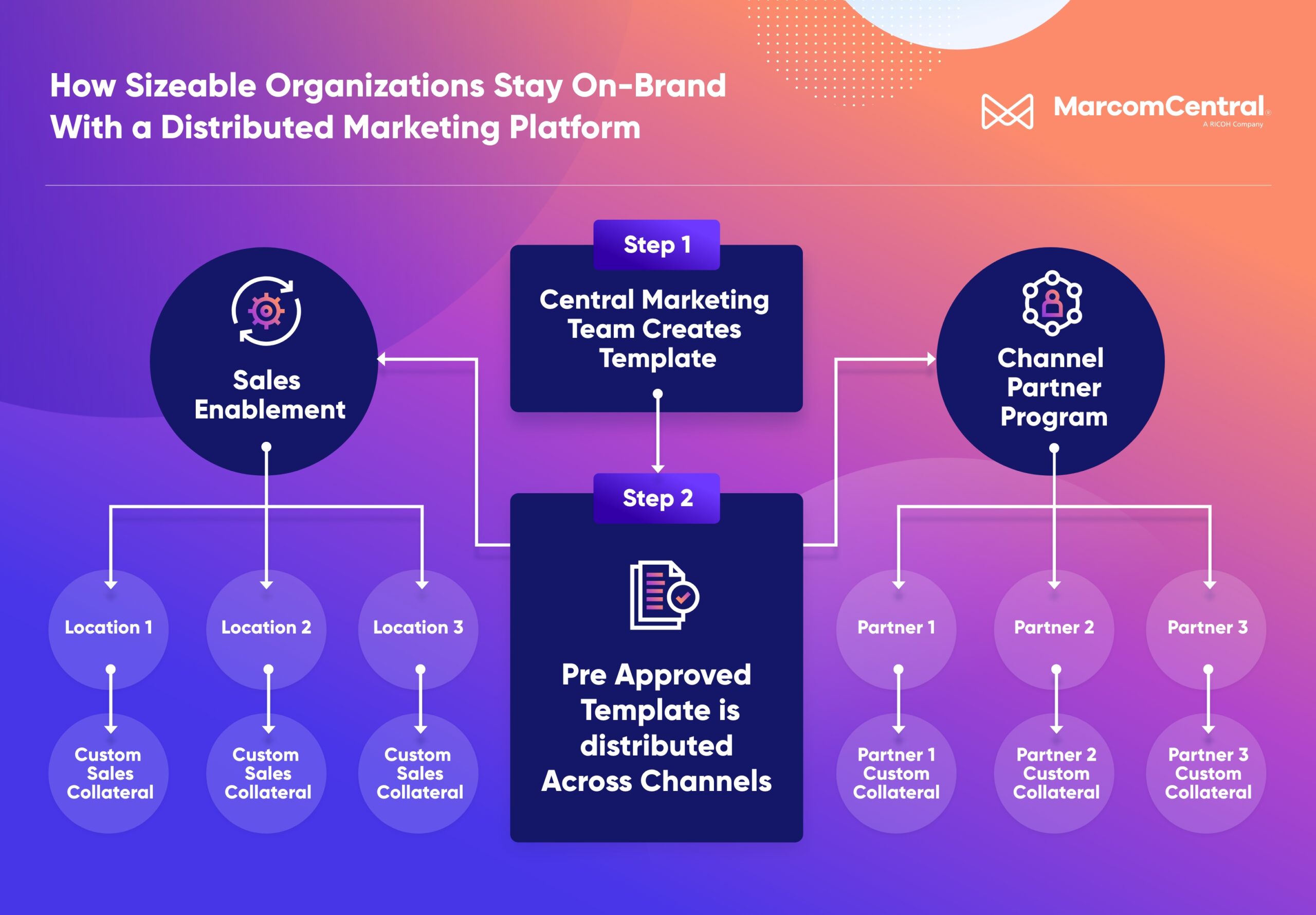Get news, updates, and insights delivered straight to your inbox.
What is Distributed Marketing, How it Works, and How It Can Improve Your Brand?

Distributed marketing makes an organization’s services available to more people by increasing production and reducing costs. For many businesses, this means access to a larger share of the market and the ability to personalize brand recognition at a more local level.
For example, the Geico brand has many partners and different sales agents. Keeping the look of their logo consistent across all channels is difficult in such an environment, but a distributed marketing model can help by providing a centralized hub where creative assets live. This allows for the assets to be easily used on partner websites or within emails to generate leads for them. A company like this one needs to make sure they don’t “spread their brand too thin” and that’s where distributed marketing platforms can make all the difference.
And that’s how a distributed marketing model improves your brand by working with you and your partners to provide a distributed marketing platform customized to fit your needs.
What Is Distributed Marketing?
Distributed marketing uses distribution channels and partners to tailor advertising and brand awareness throughout the market. Organizations can leverage relevant content to create networks of informed consumers and sell more products by scaling from global and national operations to local channels.
So what is distributed marketing? Distributed marketing management means collaboration across multiple fields to distribute and market goods.
From centralized (corporate) channels to localized (distributed) channels, distributed marketing allows businesses and organizations the flexibility to stay in control while coordinating their operations.
5 Real-Life Examples of How Distributed Marketing Works
Distributed marketing streamlines brand consistency, improves sales enablement, and offers specialized channels for client discovery.
Some real-life examples of how distributed marketing works are brand consistency, improved sales enablement, targeted distribution channels, faster turn-around, and real-time metrics.
1. Streamlined Brand Consistency
Enterprise organizations use distributed marketing by working with partner channels to streamline brand consistency.
Organizations can consistently reach across more channels through distributed marketing while maintaining consistency within their brand. This reach allows them to connect with a broader audience without compromising their core message.
2. Improved Sales Enablement
Organizations with multiple locations use distributed marketing to improve sales enablement, giving teams the resources and knowledge they need to meet organizational objectives.
Better sales enablement means more flexibility to grow and increase revenue and partnerships. By helping sales teams build content, establish guidelines, and train new talent, distributed marketing provides a valuable option for organizations looking to streamline their efforts.
3. Targeted Distribution Channels
The use of distributed marketing provides a means for businesses to deliver specific products or services to a wider audience.
Internal marketing teams leverage distributed marketing models to work with outside agencies through targeted channels. This targeting gives organizations better flexibility when working with third parties to deliver their products and services to their clients.
4. Faster Turn-Around Times
The ability to find and assess potential obstacles, define solutions, and make needed changes is essential for the long-term success of organizations that use a distributed marketing model.
Distributed marketing makes it easier for organizations to make decisions by providing automated processes that allow marketers to fine-tune their message across all channels, creating more focused strategies with less turn-around time.
5. Real-Time Performance Metrics
The use of distributed marketing software equips organizations with robust, consistent programs that can be integrated with their current workflows.
The use of cloud analytics tools and file-sharing gives distributed organizations an edge when considering how to market their products. Organizations can benefit from the many platforms offered rather than investing in new software that will be out of date within a few years.
What Is a Distributed Marketing Platform?
A distributed marketing platform makes it easier for organizations to improve branding and messaging while offering comprehensive tools for delivering content to end-users. Using software to manage projects, share files, and communicate across teams allows organizations to work more efficiently with internal and external partners.

These platforms offer a consistent experience to marketing teams, ensuring they don’t waste time learning new systems while giving them robust solutions for tracking, organizing, and managing their workloads.
How Distributed Marketing Benefits the Business
The need to effectively collaborate and discuss operations across the enterprise means organizations require standardized ways to work together and share information.
The use of distributed marketing management to ensure centralized control over diverse networks provides a way to ensure success across all channels by creating brand consistency, greater efficiency, and reduced costs.
Building Brand Consistency
Brand consistency is essential when working across diverse regions. Making sure a brand is instantly recognizable no matter where it is marketed establishes reliability for end customers.
Distributed marketing platforms allow businesses to build brand consistency by giving them the means to distribute branded products to a wide variety of end-users while maintaining a uniform brand.
Improves Marketing Production Efficiency
The delivery of marketing for products and services within a distributed environment requires coordinated efforts from the entire enterprise. Frequently, higher production comes at the cost of efficiency, but distributed marketing gives organizations the best of both worlds.
A distributed marketing platform improves marketing production efficiency by leveraging networks to ensure operations remain uninterrupted.
Reduces Marketing Costs
Within distributed networks, marketing costs can quickly become challenging to manage. Distributed marketing platforms allow businesses to share resources, centralize models, and customize messaging for specific locales.
This strategy gives distributed marketing organizations a means to control and assess the environments that they are working within, eliminating uncertainties and reducing costs.
How to Successfully Implement Distributed Marketing
The acquisition, trade, and investment of wealth present an opportunity for growth within a distributed marketing organization. Understanding how this can impact partner commitments and communication is essential to help organizations learn and improve over the long term.
There are four ways to implement distributed marketing successfully:
Invest in Marketing Asset Management
The need for flexible, scalable growth highlights the importance of considering asset management across the organizational lifecycle.
By investing in marketing asset management, organizations are better equipped to collaborate across workflows, freeing up the financial resources needed to successfully implement distributed marketing over time.
Commitment to Channel Partners
Channel partners are impacted by both opportunity and engagement, so enterprise companies should always look for better ways to work together.
Commitments to commercial partners throughout all channels present essential opportunities for implementing distributed marketing, allowing them to achieve their end goals.
High-Level Communication
Distributed marketing relies on a high level of internal and external communication to ensure organizations can connect with their target audience.
By implementing distributed marketing, organizations can collaborate across decentralized services within a centralized context, allowing them to create modern, effective marketing strategies.
Learn and Improve
The distributed marketing model helps teams find their weaknesses and improve the delivery of services, creating more value for the end-user. By implementing distributed marketing, organizations can learn and improve over time by assessing and analyzing the successes and failures of their operations.
You might also like


